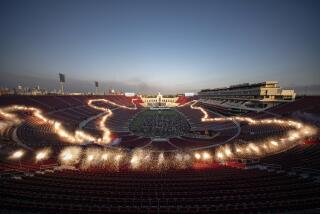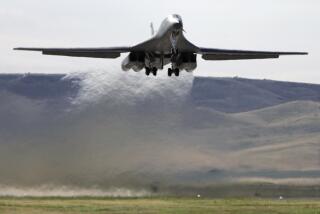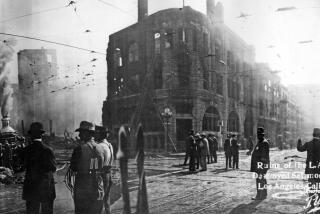Bomb Experts Teach Others About Dealing With Unthinkable
SOCORRO, N.M. — The snow is pocked with tiny furrows of blast powder. A piece of 2-inch galvanized pipe is on the ground, one end blown open. A short distance away lie pulverized shards of a watermelon.
A technician strides by, camera slung over his shoulder. He spots Van Romero, vice president of research for New Mexico Institute of Mining and Technology, looking over the damage.
“Hello, Van,” he calls. “It’s a beautiful day to blow up the neighborhood.”
It’s all in a day’s work at Tech’s Energetic Materials Research and Testing Center, a 40-square-mile test field of winding canyons, pinon- and cactus-covered volcanic hills and old mining tunnels. Here, the school does everything from training foreign police officers to using small arms to test what a blast in a luggage compartment could do to a passenger plane.
On this cold afternoon, three dozen or so police officers and firefighters have just gotten a taste of what they could face responding to an explosion.
Since 1997, Tech has trained firefighters and officers--the first responders in most disasters, human-caused or otherwise--how to save lives, protect themselves and preserve any crime scene.
To date, the school--with a student body of fewer than 1,700 in a town of 9,000--has trained thousands of first responders, who in turn train others in their departments.
The science and engineering university that grew out of the New Mexico School of Mines has done military research for decades. But after the 1995 bombing of the federal building in Oklahoma City, it began moving more toward anti-terrorism programs. Since Sept. 11, it has ratcheted up those programs.
“Our old-hat training has got to change,” said University City, Mo., police Lt. Christine Keim, a class member. “Fools rush in--and that will be us if we don’t change.”
She said Tech’s course would help first responders figure out if they can safely rescue someone or simply become another victim in the attempt. “We’re not superheroes,” she said.
Huntsville, Ala., police Lt. Henry Reyes was scheduled for the class after the terrorist attacks. Before then, he said, a lot of administrators didn’t view such training as important.
“They were saying it’s not a big deal, it’ll never happen in our city. . . . Now they understand how serious [it is],” he said.
There’s a six-month waiting list for the class. Salt Lake City-area departments are getting priority because of the Winter Olympics, which start in February.
Six tests for this day are set up on wooden platforms on a broad, snow-covered field. Some of the explosives were placed in PVC or galvanized pipe as pipe bombs. Watermelons were duct-taped to two platforms to simulate a human body.
The explosive charges ranged from a fraction of a pound up to 10 pounds in an arena test, set off at ground level inside a circle of steel and wooden poles topped with “One Way” and other signs.
Different explosives are used, including the arena test’s ammonium nitrate and fuel oil--the mix used in the Oklahoma City bombing.
“The FBI wants to know, as you approach the site of an event, is there anything you can learn as you approach,” said Ray Tobin, associate director of safety and ordinance.
“Time is important,” he lectured the class. “You want to catch the bad guy as soon as possible.”
The class crowded into a bunker atop a hill about 1,500 feet away to watch the detonations from a periscope-type arrangement of double rows of mirrors.
A countdown of “3-2-1,” then a sharp, sonic boom-like sound as the tests go off. Some explosions leave a puff of white smoke; some a streak of black; a smokeless powder one leaves no obvious sign. The final blast, the arena test, rattles the bunker.
Back on the field, street signs are warped on their poles. Holes, chest-high and fist-sized, are punched in a piece of plywood set up near the arena test to see if a human could survive behind it.
All these are telling signs to look out for on the way to a disaster, said Romero, a physics professor.
“Alarms are going off, you’re driving up and see one-way signs, stop signs, street signs bent over. Well, that wasn’t caused by a fire,” he said.
Test results also let experts extrapolate what a larger blast would do.
“If it’s 10 pounds here, we know how much more would get bent with 100 or 1000 pounds, or how much it would be bent if it was farther away,” Romero said.
A white two-room 16-by-20-foot wooden building sits nearby, each room containing a desk, a chair with a dummy and an old computer printer. Technicians will set off a letter bomb and a package bomb.
From experience, Romero knows what the blasts will do. The letter bomb blows the hands off the dummy, smashes a hole in the desk, knocks over the computer equipment. The package bomb blows the dummy back, destroys the equipment, shatters windows, knocks down ceiling tiles.
Later, an old blue Chevrolet Celebrity packed with ammonium nitrate and crashes into the structure, the 63rd car-bomb test for the year.
“You can tell by the way the metal is bent if the car held the explosive device or was a car parked next to it,” Romero said. “If it’s the car, you can get the vehicle identification number and can track back that way.”
More to Read
Sign up for Essential California
The most important California stories and recommendations in your inbox every morning.
You may occasionally receive promotional content from the Los Angeles Times.










